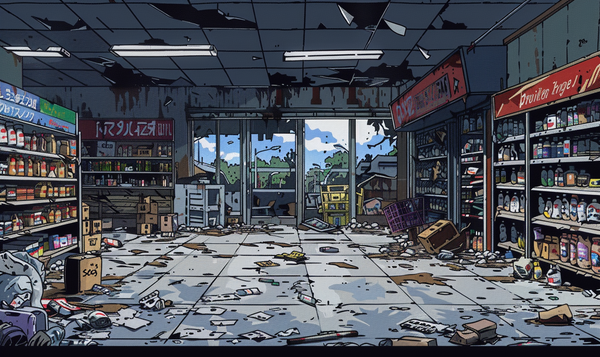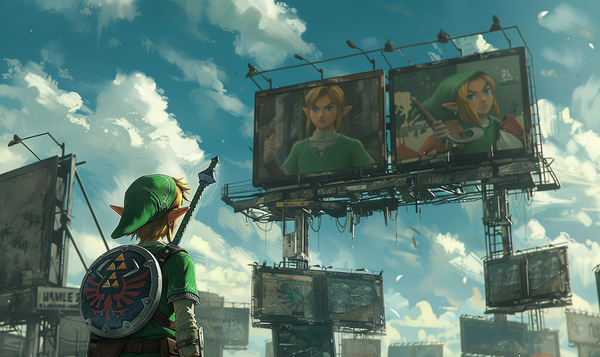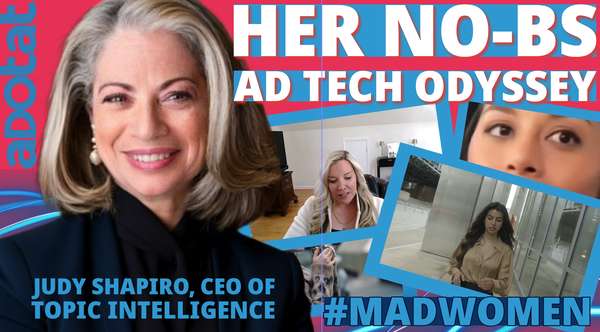Imagine, if you will, the glitziest rooftop party you’ve
ever been to. The music’s booming, champagne’s flowing, and everyone’s throwing around buzzwords like "synergy" and "disruption" without a hint of irony. That's exactly what retail media networks (RMNs) have felt like for the past few years—an absolute rager of a party where every retailer wanted a piece of the ad-tech action.
But here’s the rub: the hangover is finally catching up. And, oh boy, is it a doozy.
In Digiday's latest article, “There’s a point of diminishing returns: Why retail media’s reckoning is said to be on the horizon,” it seems our beloved RMNs—yes, those same networks touted as the ad industry’s golden goose—are finally hitting a wall. The
numbers don’t lie: once media darlings like Amazon and Walmart are now seeing their share of the pie shrink faster than you can say "CPM."
The Numbers Don’t Lie, But They Do Hurt
For years, we were all fed the dream that Retail Media Networks (RMNs) were like the Wonder Bread of the ad world: essential, irresistible, and just what the doctor ordered (assuming your doctor is into highly processed carbs).
Retail giants like Amazon, Walmart, Target, and Kroger went all-in, building ad platforms designed to wring every last dollar out of consumers’ wallets. At first, it looked like a cash-printing machine—eMarketer had RMNs hitting a staggering $54.48 billion this year, surpassing TV ad spend. That’s right, TV—the channel that once dictated family dinner schedules. But, here’s the kicker: if you squint hard enough at the numbers (and trust me, no one wanted to), you start to see the
cracks.
Keen Decision Systems just confirmed what savvy marketers have been suspecting for a while: RMN spending isn’t skyrocketing anymore. In fact, it’s nosediving. We’re talking a 33% decline, with RMNs shrinking from 19% of total media budgets in 2023 to a sad 13% in 2024. And the once-mighty Amazon, the undisputed king of retail media, has seen its market share erode, with a 24% year-over-year drop. Yeah, even Jeff Bezos can’t stop this ship from leaking.
While Walmart is high-fiving itself with a 20% share, the whole retail media landscape is starting to look a lot less invincible. RMNs are looking more like a budget black hole than the golden goose they promised to be.
Advertisers are finally waking up from their RMN-induced fever dream, realizing they might have been overspending on platforms like Amazon without seeing the sweet, sweet incremental sales they were promised. The diminishing returns are hard to
ignore. As one anonymous agency exec told Digiday, the math just isn’t adding up anymore—more money doesn't equal more sales, just like eating more pizza doesn’t equal more abs (sadly). Brands are starting to question whether sticking with these mega-networks is really worth it or if it’s time to spread their bets around with other networks like Instacart or Kroger's Precision Marketing.
The Diminishing Returns
Conundrum
The big elephant in the room for Retail Media Networks (RMNs) is undeniably diminishing returns. Throwing more money into the pot doesn’t guarantee bigger results, and brands are starting to wise up. For years, the narrative was that more ad spend equaled more sales, but reality is a bit messier. An anonymous agency executive in Digiday summed it up best: “Increased share of voice within a retailer doesn’t always translate to incremental outcomes.” In other words,
it’s not always worth pouring more dollars into these networks if the returns are stagnating or falling short.
Brands are beginning to reassess their strategies and ask the hard questions: Are Amazon and Walmart really the safe bets they once seemed? With Amazon seeing a 24% year-over-year drop in its RMN revenue, marketers are reconsidering their loyalty to the retail behemoth. Brands like Instacart and Target’s Roundel are rising stars, attracting interest from
advertisers willing to take a chance on new networks in hopes of finding better ROI.
This reconsideration isn't just about dissatisfaction with Amazon; it’s also driven by the realization that RMNs haven’t always been able to prove true incrementality. The struggle to demonstrate that ad spend is driving new sales, rather than just cannibalizing organic purchases, has put RMNs in a tough spot. Only half of CPG advertisers feel that RMNs offer unique marketing
opportunities, while the rest remain skeptical about whether these networks can actually deliver incremental growth.
What’s complicating this even more is the inconsistency in how retail networks report performance data. Metrics like return on ad spend (ROAS) are often inflated, and brands are increasingly wary of relying on the numbers provided by retailers themselves. This lack of transparency is muddying the waters, making it harder for brands to justify
increasing their spend on RMNs when they can’t even be sure of the true value they’re getting.
In response to these concerns, retailers are scrambling to justify their ad prices. Walmart, for instance, has leaned heavily into first-party data partnerships with The Trade Desk and LiveRamp to boost its credibility, but the question remains whether these efforts will be enough to stave off a broader shift away from the largest RMNs.
Retail media networks have reached a point where simply throwing money at the problem isn’t going to cut it. Marketers are now demanding more transparency, consistent metrics, and most importantly, proof of real incremental sales—because at this stage, many are wondering if their RMN dollars are being flushed down the drain.
Smaller Networks: The Scrappy Underdogs
Don’t count out the little guys in the
Retail Media Network (RMN) jungle just yet. Sure, Amazon and Walmart are the elephants stomping around, but the scrappy little meerkats—Instacart, Target’s Roundel, and even Home Depot’s rebranded Orange Apron Media—are quietly stirring up some serious dust. These smaller RMNs are like those hole-in-the-wall diners with no signage but the best food you’ve ever tasted. According to Digital Commerce 360, Target’s Roundel has grown 60% in the past two years. It's now one of the top five RMNs
in the U.S., fueled by juicy first-party data from millions of weekly shoppers. Think of it as boutique advertising with the foot traffic of a megamall—targeted, effective, and way less bloated than Amazon's lumbering empire.
Instacart, meanwhile, is playing its own game with Carrot Ads (because apparently, food puns are good for business) and forging alliances with grocery chains like Sprouts. It’s the grocery store on steroids, serving up hyper-focused,
first-party data that lets brands hit shoppers at the exact moment they’re planning dinner. It’s like getting a personalized menu from a Michelin-star chef while Amazon’s just throwing you a buffet of everything, hoping you’ll take a bite. Why blow your entire budget on Amazon’s supersized platform when Instacart can deliver higher-intent, lower-cost results?
What’s giving these smaller RMNs even more of a leg up is their ability to connect the digital with the
physical. According to Funnel.io, Target and Walmart are digitizing in-store experiences in a way that makes Amazon look like it’s stuck in 2004. We’re talking ads on shelves, checkout screens, and even kiosks that hit consumers when they’re about to pull out their credit cards. It’s the kind of in-your-face marketing Amazon can’t replicate. You’re in the store, ready to buy that toothpaste, and bam—there’s an ad for a new brand right on the shelf. It’s like having a mini Super Bowl ad
play in the middle of your weekly Target run.
And let’s not forget the power of partnerships. These little guys aren’t playing solo—they’re smart enough to bring backup. Instacart’s been buddying up with Google Shopping, while Kroger’s out here teaming up with Disney. It’s like when Batman teams up with Superman—suddenly, it’s a whole different ballgame. These smaller RMNs are punching above their weight by collaborating with platforms that can target consumers
beyond the shopping cart, giving them a real chance to land punches on Amazon and Walmart's chins.
Death by Lack of Standardization
One of the biggest hurdles RMNs face today? Standardization—or rather, the lack of it. Every retail media network seems to be playing by its own rulebook, which, surprise surprise, isn’t working out so well for brands trying to measure effectiveness. CVS is using one method;
TikTok is doing something else entirely, and trying to manage these permutations has become an ad exec’s worst nightmare.
Here’s the kicker: even with all the “first-party data” that RMNs are hoarding like it’s the last loaf of bread on the shelf, the actual ROI is murky at best. Mike Feldman from VaynerMedia put it best, telling Digiday that if RMNs don’t start proving their worth, consolidation is on the horizon. Because,
let’s face it, not everyone can get away with charging $33 CPMs for CTV ads when third-party cookies (you know, the things Google keeps threatening to kill but never actually does) are back on the table and often come cheaper.
So, in a desperate bid to make sense of this hot mess, the IAB is stepping in with their Retail Media Network Lookbook. According to Jeffrey Bustos, VP of measurement and addressability data at IAB, this
little guidebook is supposed to help retailers, brands, and agencies navigate the increasingly crowded RMN landscape. But here's the rub: with a never-ending parade of RMNs popping up, bloated costs, and no real standards in sight, trying to measure success across these walled gardens is like herding cats.
The Future? Maybe Just Fewer Silos, Please
Retail media networks were once the cool kids in the
ad-tech cafeteria, offering something that seemed revolutionary—hyper-targeted ads backed by first-party shopper data. But as Justin Jefferson from Keen Decision Systems pointed out to Retail Insider, many brands are realizing that the incrementality and profitability of RMNs aren’t always there. Brands were overspending on Amazon and the like, and now they’re finally starting to wise up.
The moral of the story? The shiny
veneer of RMNs is wearing thin. Unless these networks can start offering real, tangible benefits—like offline data integration (seriously, why isn’t this a thing yet?) and more standardized measurement—this crash is going to feel less like a slow decline and more like Wile E. Coyote running off a cliff, looking down, and realizing there’s nothing holding him up.
In the words of every wise marketer at the bar: it’s time to start
shopping smarter, not harder.
COMMENT ABOUT THIS ARTICLE WITH OTHER EXPERTS ON LINKEDIN



















